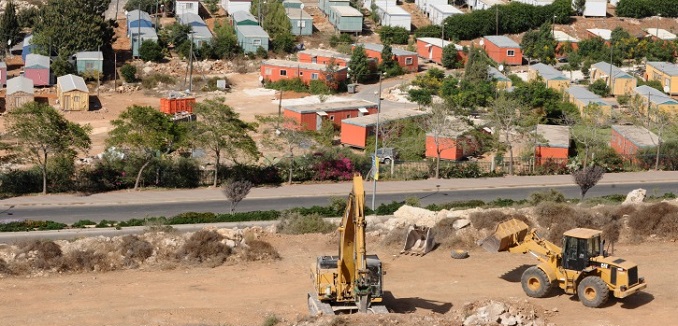The Green Line has returned with a vengeance. Decades of efforts to erase it have come to naught. If United Nations Security Council Resolution 2334, Secretary of State John Kerry’s subsequent speech, and Sunday’s Paris peace conference have proven anything, is that the Green Line has struck back.
That’s a good thing.
The Green Line, commonly referred to as the June 1967 line and more precisely referred to as the 1949 armistice line, separates the West Bank from the State of Israel. But more importantly, it separates the Zionism that built the country from the Zionism that could destroy it. The return of the Green Line in international discourse is an opportunity to revive the much-needed debate between Zionism-of-the-people and Zionism-of-the-land, between secular Zionism and messianic Zionism, between the original Zionism of sovereignty and the later, mutated Zionism of idolatry.
Zionism was the movement of a people who sought their liberation by becoming masters of their own fate. It was not the movement of a people who wanted to become slaves to a land. Zionism was born so that the Jewish people would be free in a land of their own, but not so they would own the land in its entirety. The reason that the Zionist movement was so remarkably successful in achieving its goals was precisely due to its laser-sharp focus on sovereignty rather than land; so much so that to attain a state for the Jewish people that was sanctioned by the United Nations, the Zionist leadership was willing to accept a partition plan that allowed for the creation of a Jewish state without Jerusalem—without the Zion in Zionism—and without Judea, the last place where Jewish sovereignty reigned.
In terms of examples of historical leadership, this decision of the Zionist movement to accept partition, and to avoid the trap of messianic greed, could count as miraculous. Had the Zionist leadership dropped the ball on its supreme goal of sovereignty, the Jewish people would have probably had neither liberty nor land. Moreover, the moral courage of the Zionist leadership in saying “I do” to 54 percent of the land between the Jordan River to the Mediterranean Sea (most of it desert), even though it was promised 100 percent by the League of Nations, stood out against the Arab maximalist demand of 100 percent. This stance was rewarded when, at the end of the 1948-1949 war, the state of Israel was recognized by many of the world’s nations on territory comprising 78 percent of the land—that is, the territory within the armistice lines. By saying yes to less, Israel gained more. By saying all or nothing, the Arabs were left with nothing.
This ancient Talmudic lesson that was demonstrated so exquisitely by the divergent Zionist and Arab responses to partition—tafasta meruba lo tafasta (try to grab too much and you’ll be left with nothing)—has been lost on the messianic settler movement. For several decades now, the movement has sought to erase the distinction between the state of Israel and the land of Israel. By settling in the territories that Israel captured in the 1967 Six-Day War, and especially by doing so under the mantle of religion, it sought to refashion Zionism as a movement that is a about the land of Israel rather than the people of Israel.
A message for those who imagined that the settlers were successful in their cause—whether they were pleased or concerned by it—came in the form of last month’s Security Council resolution, which resurrected with force the 1949 armistice lines. It reminded those in Israel, and those outside it who have been taken by the ideological fervor of the settler movement, that the movement is bereft of international support. By taking such great pains to emphasize that all that is beyond the Green Line does not belong to Israel, the resolution essentially affirmed what does belong to Israel. The resolution, even if this was not the intention, gives international sanction to the Zionism that created Israel within the Green Line—the secular Zionism of a people seeking nothing more than their liberty and equality among the nations. By condemning the settlements so harshly, the resolution powerfully rejected the post-1967 mutation of Zionism by the settlers into a Messianic religious movement that subjects a people to the false idolatry of land and greed.
There is nothing sacrosanct in the 1949 armistice lines, but in the absence of the State of Israel delineating a clear border within the West Bank that puts a final limit on its territorial claims, the Green Line has become the line that distinguishes the kind of Israel that the world is willing to support from the kind that it is not. Even if unintended, the events of the past month have been a powerful affirmation of the remarkable achievements of secular Zionism, and a warning sign of the dangers of greed. It gives an opportunity to all of us who are heirs to that original Zionist vision, to proudly say: We are privileged to be free and sovereign in the land of our ancestors, and we do not need to own every part of it to know that we are of it.
Einat Wilf was chair of the Education Committee and member of the Foreign Affairs and Defense Committee in the 18th Knesset, has a BA in government and fine arts from Harvard University, an MBA from INSEAD in France and a PhD in political science from the University of Cambridge. Previously, she served as a senior fellow with the Jewish People Policy Planning Institute, a foreign policy advisor to then-vice prime minister Shimon Peres and a strategic consultant with McKinsey & Company. Wilf is the author of three books that explore key issues in Israeli society, including My Israel, Our Generation (BookSurge, 2007).
[Photo: Gili Yaari]




